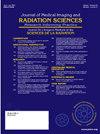The effect to dose and diagnostic quality of limiting source-to-image distance on anterior-posterior semi-erect adult chest X-rays
IF 1.3
Q3 RADIOLOGY, NUCLEAR MEDICINE & MEDICAL IMAGING
Journal of Medical Imaging and Radiation Sciences
Pub Date : 2025-05-17
DOI:10.1016/j.jmir.2025.101986
引用次数: 0
Abstract
Introduction
Mobile chest X-rays (CXR) examinations are requested for clinically unstable inpatients who cannot be transported to the radiology department. These examinations often have limitations, such as reduced source-to-image distance (SID) in anterior-posterior (AP) position due to limited space in ward environments. This study aimed to investigate the effect of entrance skin dose (ESD) and the diagnostic image quality of reduced SID from the standard 180cm to 150cm and 100cm on semi-erect AP CXRs.
Method
A human tissue equivalent Alderson Rando phantom was positioned in a hospital bed at an AP semi-erect 45-degree angle. Three exposures were taken for each SID; the dose was recorded with an Ion Chamber attached to the anterior chest wall to record the ESD and the dose area product (DAP). The mean dose from the three SID positions was compared using a t-test. Image quality was assessed using Image Quality Score (IQS) and RadLex criteria for diagnostic quality using Analysis of Variance (ANOVA).
Results
A linear response of decreasing the SID resulted in a 40.1 % increase in ESD (53.7 μGy; p = < 0.001) from 180 cm to 150 cm SID and a 121.5 % increase (329.9 μGy; p = < 0.001) from 180 cm to 100 cm SID. There was also a decrease in image quality from 180 cm to 100 cm SID (IQS p = 0.03), with 100 cm scoring poor against lower lung field visual reproduction and limited diagnostic quality on RadLex.
Conclusion
The findings demonstrate that in controlled X-ray settings, the ESD is increased when the SID is reduced from 180cm to 150cm SID (40.1 %) and to 100cm SID (121.5 %), which furthermore decreases image quality (p = 0.03) and the diagnostic value of the image. It is recommended that radiographers maintain the standard 180 cm SID during adult inpatient semi-erect AP CXR examinations to maintain as low as reasonably practicable (ALARP) diagnostic X-ray examinations.
限制源像距离对成人前后半直立胸部x线片剂量和诊断质量的影响
临床不稳定的住院患者不能被转移到放射科,需要进行移动胸部x光检查。这些检查通常有局限性,例如由于病房环境中空间有限,在前后(AP)位置减少了源到图像距离(SID)。本研究旨在探讨入口皮肤剂量(ESD)对半直立AP x射线成像的影响,以及从标准180cm降低到150cm和100cm的SID诊断图像质量的影响。方法将人体组织等效Alderson随机模体以AP半直立45度角放置在病床上。每个SID进行三次暴露;用附着于前胸壁的离子室记录剂量,记录ESD和剂量面积积。三个SID位置的平均剂量采用t检验进行比较。采用图像质量评分(IQS)和RadLex诊断质量标准,采用方差分析(ANOVA)对图像质量进行评估。结果降低SID的sa线性响应导致ESD (53.7 μGy)增加40.1 %;P = <;0.001),从180 cm增加到150 cm,增加了121.5 % (329.9 μGy;P = <;0.001)从180厘米到100厘米的SID。从180 cm到100 cm的图像质量也有所下降(iq p = 0.03),其中100 cm对较低的肺野视觉再现评分较差,RadLex上的诊断质量有限。结论在控制x线设置下,当SID从180cm降低到150cm(40.1 %)和100cm(121.5 %)时,ESD增加,进一步降低了图像质量(p = 0.03)和图像的诊断价值。建议放射技师在成人住院患者半直立AP x射线检查时保持标准180厘米的SID,以保持尽可能低的合理可行(ALARP)诊断x射线检查。
本文章由计算机程序翻译,如有差异,请以英文原文为准。
求助全文
约1分钟内获得全文
求助全文
来源期刊

Journal of Medical Imaging and Radiation Sciences
RADIOLOGY, NUCLEAR MEDICINE & MEDICAL IMAGING-
CiteScore
2.30
自引率
11.10%
发文量
231
审稿时长
53 days
期刊介绍:
Journal of Medical Imaging and Radiation Sciences is the official peer-reviewed journal of the Canadian Association of Medical Radiation Technologists. This journal is published four times a year and is circulated to approximately 11,000 medical radiation technologists, libraries and radiology departments throughout Canada, the United States and overseas. The Journal publishes articles on recent research, new technology and techniques, professional practices, technologists viewpoints as well as relevant book reviews.
 求助内容:
求助内容: 应助结果提醒方式:
应助结果提醒方式:


